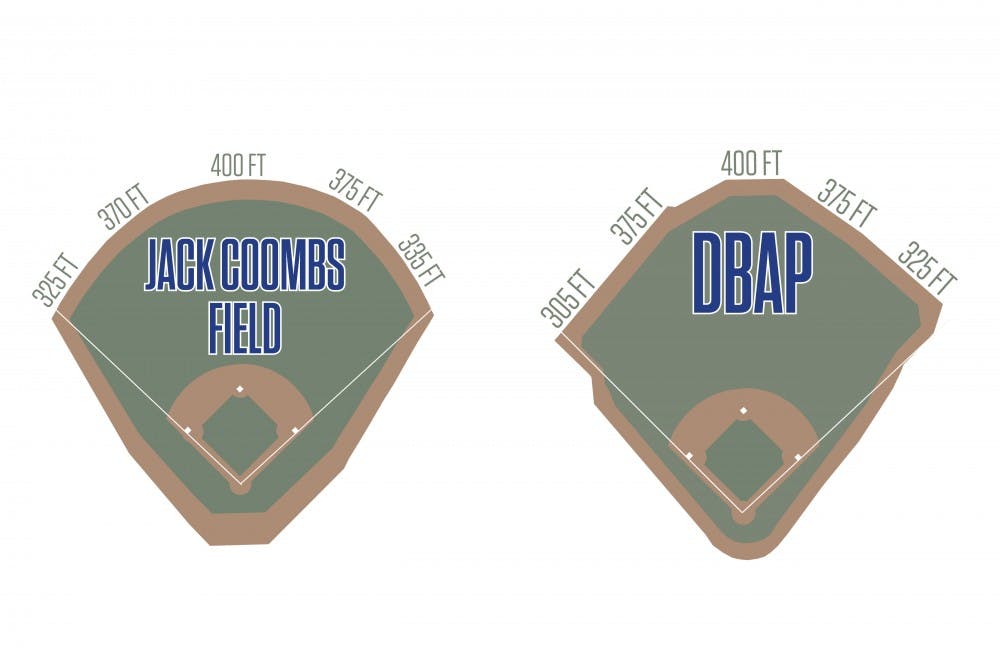It’s that time of year again—baseball season.
Yes, college basketball is entering the stretch run of conference play and a top-10 team loses seemingly every day to create plenty of intrigue and parity as March Madness approaches. And there’s the NBA in the middle of its season as well, with the Golden State Warriors gunning for history and the San Antonio Spurs not far behind.
But February brings with it the year’s first sizzling fastballs and screaming line-drives amid the warmth of Florida and Arizona. As spring training starts to get in full swing and pitchers are hitting the golf courses for their afternoon tee times following morning bullpen sessions, the Blue Devils are playing games that count for real in their new home park.
Per an agreement the team reached in October, Duke will play 36 home games at the Durham Bulls Athletic Park in downtown Durham this year, as opposed to just six on campus at Jack Coombs Stadium. The Blue Devils got off to a great start at the DBAP last weekend, escaping with a series victory against then-No. 10 California thanks to a pair of walk-off victories and then shutting out Campbell in a midweek tilt.
Duke head coach Chris Pollard has been particularly excited about the team’s move downtown, citing the DBAP’s great facilities and a positive relationship with the Durham community. With a change of venue, though, comes slight changes in how the game is played, and Pollard pointed to the DBAP’s reputation as an offensive park—as opposed to Coombs, which is known for being pitcher-friendly—as something his team would look to take advantage of this season.
The most distinctive feature of the DBAP is the Blue Monster, a 32-foot-tall fence that extends far into the left-center field gap. The Blue Monster is very short down the line—just 305 feet, compared to 325 at for Coombs—creating plenty of opportunities for home runs or doubles on balls that would likely be outs in other parks.
Coombs’ fences are as deep or deeper than the DBAP’s at all major measuring junctures. The two both check in at 400 feet in dead center and 375 in the right-center field alley, but Coombs is 10 feet deeper down the right-field line at 335 and five feet deeper in left-center at 375.
Since Pollard took the helm prior to the 2013 season, Duke has played 32 games at the DBAP and won 17 of them, good for a .531 winning percentage. Overall, Pollard has compiled a .543 winning percentage with the Blue Devils—so not a significant difference there.
The biggest difference comes, perhaps not unsurprisingly, in the power department. Duke has launched a home run in 14 of its 32 games at the DBAP during Pollard’s tenure, a remarkably high rate for a team that collected just 13 total round-trippers in 53 games last season. Pollard often has often called the DBAP as a welcoming environment for right-handed power hitters, and indeed Andy Perez—the team’s right-handed hitting second baseman last season—knocked six of his nine career homers at the DBAP.
Other than home runs, though, there is not much evidence to suggest the Blue Devils hit any differently at the DBAP than at Coombs. Despite the extra bump from long balls, Duke actually did not hit more extra-base hits downtown. The team averaged 2.2 extra-base hits at the DBAP against 2.30 in 23 home games at Coombs last season, with the extra space in Coombs more than making up for the Blue Monster’s shorter porch in left.
Scoring wise, Duke was slightly less productive at the DBAP, scoring 5.31 runs per game there but 5.35 at Coombs and 5.65 in 20 road games last season.
On the flip side, the Blue Devils’ run prevention was slightly better at the DBAP, even with inferior underlying numbers. Duke yielded 4.63 runs per game at the DBAP and opponents scored 4.70 runs per game at Coombs, but the Blue Devil staff struck out .74 fewer batters and allowed .32 more hits per game in their away-from-campus home games.
Duke heads back to the DBAP Tuesday for a nonconference clash with Davidson before playing a stretch of 12 straight there in March. This time, maybe sophomore Evan Dougherty—who blasted three dingers Friday against Ohio State—will clear the fences with regularity and send a few soaring over the Blue Monster.
Get The Chronicle straight to your inbox
Signup for our weekly newsletter. Cancel at any time.

